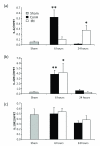Interleukin-22: implications for liver ischemia-reperfusion injury
- PMID: 22262131
- PMCID: PMC3402175
- DOI: 10.1097/TP.0b013e3182449136
Interleukin-22: implications for liver ischemia-reperfusion injury
Abstract
Background: Ischemia-reperfusion injury (IRI) is common in general surgery and organ transplantation, and in the case of liver, it triggers proinflammatory innate immune cascade and hepatic necrosis, leading to increased incidence of early and late organ rejection. Interleukin (IL)-22, an inducible cytokine of T-cell origin and a member of the IL-10 superfamily, acts on target tissues through IL-22 receptor (IL-22R1).
Methods: Partial hepatic warm ischemia was induced in C57Bl/6 wild-type (WT) and type 1 interferon receptor-deficient (KO) mice for 90 min followed by 6 to 24 hr of reperfusion. WT mice were treated at 30 min before the ischemia insult with recombinant IL-22 or anti-IL-22 neutralizing antibody; phosphate-buffered saline and IgG served as respective controls.
Results: IL-22 was detected at 24 hr but not 6 hr of liver IRI. The expression of IL-22R1 was increased by 6 hr of reperfusion in WT but not type 1 interferon receptor KO mice that were protected from IRI. Treatment of WT mice with recombinant IL-22 decreased serum aspartate aminotransferase levels, ameliorated cardinal histological features of IR damage (Suzuki's score) and diminished leukocyte sequestration, along with the expression of IL-22R1 and pro-inflammatory cytokines. IL-22 antibody did not appreciably affect IRI but increased IL-22R1 transcription in the liver. Administration of IL-22 protein exerted hepatoprotection by STAT3 activation.
Conclusions: This is the first report investigating immune modulation by T-cell-derived IL-22 in liver injury caused by warm ischemia and reperfusion. Treatment with IL-22 protein may represent a novel therapeutic strategy to prevent liver IRI in transplant recipients.
Figures





Similar articles
-
Viral interleukin-10 gene transfer prevents liver ischemia-reperfusion injury: Toll-like receptor-4 and heme oxygenase-1 signaling in innate and adaptive immunity.Hum Gene Ther. 2007 Apr;18(4):355-66. doi: 10.1089/hum.2007.181. Hum Gene Ther. 2007. PMID: 17439357
-
Absence of toll-like receptor 4 (TLR4) signaling in the donor organ reduces ischemia and reperfusion injury in a murine liver transplantation model.Liver Transpl. 2007 Oct;13(10):1435-43. doi: 10.1002/lt.21251. Liver Transpl. 2007. PMID: 17902130
-
Hepatic preconditioning using lipopolysaccharide: association with specific negative regulators of the Toll-like receptor 4 signaling pathway.Transplantation. 2011 May 27;91(10):1082-9. doi: 10.1097/TP.0b013e31821457cb. Transplantation. 2011. PMID: 21403587
-
CD4+ T Cell NRF2 Signaling Improves Liver Transplantation Outcomes by Modulating T Cell Activation and Differentiation.Antioxid Redox Signal. 2023 Mar;38(7-9):670-683. doi: 10.1089/ars.2022.0094. Epub 2023 Mar 1. Antioxid Redox Signal. 2023. PMID: 36070449 Free PMC article. Review.
-
Molecular mechanisms of liver ischemia reperfusion injury: insights from transgenic knockout models.World J Gastroenterol. 2013 Mar 21;19(11):1683-98. doi: 10.3748/wjg.v19.i11.1683. World J Gastroenterol. 2013. PMID: 23555157 Free PMC article. Review.
Cited by
-
Interleukin-22 ameliorates acute severe pancreatitis-associated lung injury in mice.World J Gastroenterol. 2016 Jun 7;22(21):5023-32. doi: 10.3748/wjg.v22.i21.5023. World J Gastroenterol. 2016. PMID: 27275094 Free PMC article.
-
Novel treatment of acute and acute-on-chronic liver failure: Interleukin-22.Liver Int. 2025 Mar;45(3):e15619. doi: 10.1111/liv.15619. Epub 2023 May 19. Liver Int. 2025. PMID: 37208937 Review.
-
Pro-Inflammatory Signaling by IL-10 and IL-22: Bad Habit Stirred Up by Interferons?Front Immunol. 2013 Feb 4;4:18. doi: 10.3389/fimmu.2013.00018. eCollection 2013. Front Immunol. 2013. PMID: 23382730 Free PMC article.
-
Interleukin-22: immunobiology and pathology.Annu Rev Immunol. 2015;33:747-85. doi: 10.1146/annurev-immunol-032414-112123. Epub 2015 Feb 11. Annu Rev Immunol. 2015. PMID: 25706098 Free PMC article. Review.
-
How Does Interleukin-22 Mediate Liver Regeneration and Prevent Injury and Fibrosis?J Immunol Res. 2016;2016:2148129. doi: 10.1155/2016/2148129. Epub 2016 Dec 6. J Immunol Res. 2016. PMID: 28050571 Free PMC article. Review.
References
-
- Land W, Messmer K. The impact of ischemia/reperfusion injury on specific and non-specific early and late chronic events after organ transplantation. Transplant Rev. 1996;10:108.
-
- Fondevila C, Busuttil RW, Kupiec-Weglinski JW. Hepatic ischemia/reperfusion injury- -a fresh look. Exp Mol Pathol. 2003;74:86. - PubMed
-
- Zhai Y, Shen XD, O’Connell R, et al. Cutting edge: TLR4 activation mediates liver ischemia/reperfusion inflammatory response via IFN regulatory factor 3-dependent MyD88-independent pathway. J Immunol. 2004;173:7115. - PubMed
Publication types
MeSH terms
Substances
Grants and funding
LinkOut - more resources
Full Text Sources
Other Literature Sources
Research Materials
Miscellaneous

